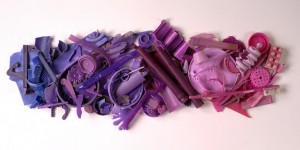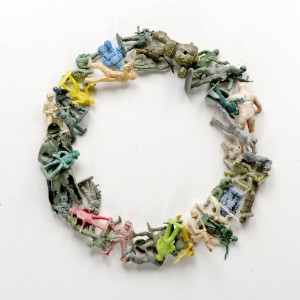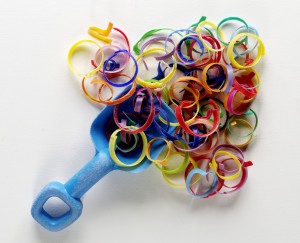If you are looking for some new sources of inspiration, we’d like to introduce you to some distinctive artists, designers, and illustrators—both past and present—that we think ‘you should know.’ Some may be lesser known while others may seem vaguely familiar, either way you will discover unique talents that might just influence your next project.
During their first date in 1999, Richard Lang and Judith Selby learned they had an unusual habit in common. While strolling along Kehoe Beach in Northern California’s Point Reyes National Seashore, they both picked up small pieces of plastic among the sand. Come to find out, these two visual artists and designers had been independently collecting assorted beach debris over several years for use in their work.1
A personal and professional partnership quickly blossomed from that first date for the now married couple. As Richard puts it, “We could never have imagined, on that day, what an incredible life would unfold – picking up other people’s garbage.”1
For over a decade, the Langs have been using their artistic collaboration to tell a story of the interplay between our planet and our impact on it. Focusing their efforts on a single 1,000-yard stretch of beach, they have amassed over two tons of discarded plastic items. The materials are cleaned, cataloged through extensive research, and sorted using Bauhaus methods before the couple incorporates the found objects into understated sculptural assemblages, which upon deeper observation are surprisingly provocative.2

“We want to entice people with the beauty. We want to ensnare them,” says Judith.2
The outwardly approachable style of their pieces, at first glance deceives the viewer. A monochromatic series of filled dinner plates to a colorful wreath made of children’s hair clips, their work beguiles at the start then quickly delivers a powerful message about the role we all play in our surrounding environment.

“There’s this wonderful dance that happens when people look at our displays,” says Judith. “They’ll be intrigued and will move forward and look at the artwork, and sometimes they’ll recoil and say, ‘Eww, what is that?’ and then they’ll move forward again. Often they’ll say, ‘Wow, I used to have one of those.’”3
When people see something similar to an item they owned or used in the finished sculpture, be it a toy soldier or a sample spoon from a yogurt shop, they develop a personal relationship with the piece and begin to see their place in the cycle of pollution. This message is what the Langs hope to evoke in everyone that engages with their artwork.

Fittingly enough, the first solo exhibit of their joint work was displayed at the main visitor’s center within Point Reyes National Seashore. Entitled “One Beach, One Year,” the exhibited pieces chronicled the discarded and washed-up plastic the couple gathered over the course of twelve months along their designated 1,000 yards of beach.3
“[Their artwork] really had a direct impact on people,” says Loretta Farley, an interpretive ranger at the park, “much more so than a pile of trash or signs saying ‘Don’t Litter.’”3
As an extension of the exhibit, the Langs also led park visitors on field trips to collect their own beach plastic and then turn it into art. Encompassing plastic bits and pieces from all over the Pacific Rim and dating as far back as the 1940s, the exhibit and guided ‘debris tours’ had a lasting impression on park visitors and staff that extends to today.3
“When you visit the park and you’re immersed in this natural environment, you don’t necessarily realize the human labor that’s involved,” says Loretta. “It’s the behind-the-scenes story of national parks – people like Judith and Richard who are out there cleaning beaches and clearing trails. They’re not just looking to a government agency to solve a problem; they’ve taken ownership, and they’re stepping up to work with the Park Service and create a solution.”3
Following this first successful exhibit, the Langs’ artistic creations have traveled to galleries and museums throughout the country and abroad. As artists and designers, they are using their professional collaboration to advance the conversation of global pollution.

They will be the first to admit, not all plastic is bad, as it can serve a much-needed function in society – from eyeglasses to prosthetic limbs. It is the disposable, single-to-limited-use plastic that is the real problem and the primary focus of their body of work. By addressing the ‘use and toss’ form of plastic, the Langs force people to see the potential collective effect they can have by making smarter personal choices regarding their waste footprint.2
Says Judith, “We have taken on 1,000 yards of one beach, just a tiniest portion of the planet. But if everyone takes on a small part, that’s where to begin.”4
To learn more about Richard Lang and Judith Selby Lang or to view more samples of their work visit www.beachplastic.com. To discover how the couple gathers materials and develops their work, watch this short video.5
1 Greenwald, Jeff. “Making Beautiful Art Out of Beach Plastic.” Smithsonian Magazine. Smithsonian Institution. 14 July 2011. Web. 8 Oct. 2013.
2 “A Deeper Dive with Richard and Judith Lang.” Barefoot Wine [barefootwine]. YouTube. 18 Sep. 2011. Web. 4 Oct. 2013.
3 Marquis, Amy Leinbach. “Found Objects: Two Artists Turn Trash into Treasures at Point Reyes National Seashore.” National Parks Magazine. National Parks Conservation Association. Summer 2012. Web. 4 Oct. 2013.
4 Dukehart, Coburn. “Likes Long Walks on the Beach, Collecting…Plastic?” The Picture Show. National Public Radio. 1 Aug. 2012. Web. 8 Oct. 2013.
5 “One Plastic Beach.” High Bean Media. Vimeo. 2011. Web. 4 Oct. 2013.
Lang, Richard and Judith Selby. Assorted Artwork. n.d. Mixed Media Digital Prints. Web. 8 Oct. 2013. www.beachplastic.com
Lora Davis Stocker is a freelance designer, illustrator and artist based in the Greater Triangle Area of NC. With diverse experience in print and digital environments, Lora enjoys working with clients of all types from small, mom and pop businesses to large global brands.